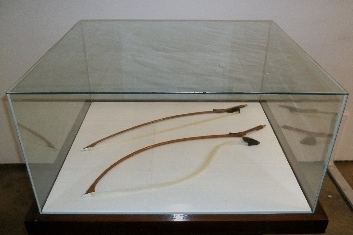 | ||
The curved bow for string instruments enables string players to control the tension of the bow hair in order to play one, two, three and four strings simultaneously and to change easily among these possibilities. The high arch of the bow allows full, sustained chords to be played and there is a lever mechanism that affects the tension and release of the bow hair.
Contents
Polyphonic playing
The practice of polyphonic playing is documented by Alessandro Striggio (1540–92), violinist Nicolaus Bruhns (1665–97), and German violinist Johann Paul von Westhoff (1656–1705), who also developed a unique notation for that. There exist also some polyphonic pieces for violin and viola by Niccolò Paganini (1782–1840), documented by Dr. Philippe Borer. 3
The Bach bow
Ever since the publication in 1905 of Albert Schweitzer's book about J. S. Bach, the question of the curved bow has been widely debated. For Schweitzer, however, use of the curved bow was essential in performing Bach’s string works. Asked to write something for the Bach year in 1950 (Bach-Gedenkschrift), forty-five years after his original study, Schweitzer still focused on his ideas about the curved bow.
David Dodge Boyden and other musicologists provided compelling arguments against the authenticity of the "Bach bow". According to them, historic indications as to a strongly curved bow in the 18th century are missing, and the curved bow is said to have a lack of dynamic potential. There are images of strongly curved bows from mediaeval times, but these have taut hair. Two texts, on the other hand, document use of the curved bow in modern times, mainly as a means to better analyze polyphonic baroque music: Rudolf Gaehler’s book Der Rundbogen für Violine - ein Phantom? (The Curved Bow for Violin - a Phantom?), and Michael Bach’s article on the Suites for Cello of J.S.Bach.
In 1990, German cellist Michael Bach invented a curved bow for cello, violin, viola and bass. He named it "BACH.Bogen" (BACH.Bow). During the years 1997 and 2001, Mstislav Rostropovich was intimately involved in the development and testing of the BACH.Bogen. He invited Michael Bach to present his curved bow on the occasion of the 7ème Concours de violoncelle Rostropovitch in Paris 2001. In 2012, during an exhibition on the theme «BACHLAEUFE - The Imprint of Johann Sebastian Bach on Modern Times», held at Arnstadt, Germany, the First Prize was awarded to the BACH.Bow.
John Cage, Dieter Schnebel, Walter Zimmermann and Hans Zender have written works for the curved bow which explore the new perspectives and potential of it.
Violin bows
The curved bow for violin was firstly constructed by Hungarian violinist Emil Telmányi and Knud Vestergaard, a Danish violin- and bowmaker in 1949 for performing Sonatas and Partitas for violin solo by Johann Sebastian Bach.
The violinist Tossy Spivakovsky used a curved bow with which he performed the Bach Sonatas and Partitas for unaccompanied violin. An article written by Spivakovsky entitled "Polyphony in Bach's Works for Solo Violin," published in 1967 in The Music Review, Vol. 28, No. 4, provides evidence that Bach wanted certain chords in his solo violin suites played without arpeggiation. A curved bow, or "Bach Bow", which Spivakovsky acquired from Knud Vestergaard of Denmark, enabled him to execute the whole four-string chords of the Bach sonatas and partitas with greater ease and sonority.
